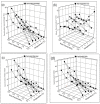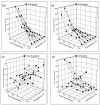Using Halothermal Time Model to Describe Barley (Hordeumvulgare L.) Seed Germination Response to Water Potential and Temperature
- PMID: 35207497
- PMCID: PMC8878096
- DOI: 10.3390/life12020209
Using Halothermal Time Model to Describe Barley (Hordeumvulgare L.) Seed Germination Response to Water Potential and Temperature
Abstract
Barley (Hordeum vulgare L.) is a salt-tolerant crop with considerable economic value in salinity-affected arid and semiarid areas. In the laboratory experiment, the halothermal time (HaloTT) model was used to examine barley seed germination (SG) at six constant cardinal temperatures (Ts) of 15, 20, 25, 30, 35, and 40 °C under five different water potentials (ψs) of 0, -0.5, -1.5, -1.0, and -2.0 MPa. Results showed that at optimum moisture (0 MPa), the highest germination percentage (GP) was recorded at 20 °C and the lowest at 40 °C. Moreover, GP increased with the accelerated aging period (AAP) and significantly (p ≤ 0.05) decreased with high T. In addition, with a decrease of ψ from 0 to -0.5, -1, 1.5, and -2.0 MPa, GP decreased by 93.33, 76.67, 46.67, and 33.33%, respectively, in comparison with 0 MPa. The maximum halftime constant (θHalo) and coefficient of determination (R2) values were recorded at 20 °C and 30 °C, respectively. The optimum temperature (To) for barley is 20 °C, base Ψ of 50th percentile (Ψb (50)) is -0.23 Mpa, and standard deviation of Ψb (σΨb) is 0.21 MPa. The cardinal Ts for germination is 15 °C (Tb), 20 °C (To), and 40 °C (Tc). The GP, germination rate index (GRI), germination index (GI), coefficient of the velocity of germination (CVG), germination energy (GE), seed vigor index I and II (SVI-I & II), Timson germination index (GI), and root shoot ratio (RSR) were recorded maximum at 0 MPa at 20 °C and minimum at -2.0 MPa at 40 °C. Mean germination time (MGT) and time to 50% germination (T 50%) were maximum at -2 MPa at 40 °C, and minimum at 20 °C, respectively. In conclusion, the HaloTT model accurately predicted the germination time course of barley in response to T, Ψ, or NaCl. Therefore, barley can be regarded as a salt-tolerant plant and suitable for cultivation in arid and semi-arid regions due to its high resistance to salinity.
Keywords: barley; cardinal temperatures; halothermal time model; seed germination; water potential.
Conflict of interest statement
Authors have no conflict of interest.
Figures






Similar articles
-
Validating the Impact of Water Potential and Temperature on Seed Germination of Wheat (Triticum aestivum L.) via Hydrothermal Time Model.Life (Basel). 2022 Jun 30;12(7):983. doi: 10.3390/life12070983. Life (Basel). 2022. PMID: 35888073 Free PMC article.
-
Computing the effects of temperature and osmotic stress on the seed germination of Helianthus annuus L. by using a mathematical model.Sci Rep. 2024 May 1;14(1):9978. doi: 10.1038/s41598-024-60015-8. Sci Rep. 2024. PMID: 38693252 Free PMC article.
-
Using mathematical models to evaluate germination rate and seedlings length of chickpea seed (Cicer arietinum L.) to osmotic stress at cardinal temperatures.PLoS One. 2021 Dec 17;16(12):e0260990. doi: 10.1371/journal.pone.0260990. eCollection 2021. PLoS One. 2021. Retraction in: PLoS One. 2022 Aug 3;17(8):e0272196. doi: 10.1371/journal.pone.0272196. PMID: 34919542 Free PMC article. Retracted.
-
Halothermal and hydrothermal time models describe germination responses of canola seeds to ageing.Plant Biol (Stuttg). 2021 Jul;23(4):621-629. doi: 10.1111/plb.13251. Epub 2021 Apr 23. Plant Biol (Stuttg). 2021. PMID: 33683764
-
Utilizing hydrothermal time models to assess the effects of temperature and osmotic stress on maize (Zea mays L.) germination and physiological responses.BMC Plant Biol. 2023 Sep 7;23(1):414. doi: 10.1186/s12870-023-04429-y. BMC Plant Biol. 2023. PMID: 37679677 Free PMC article.
Cited by
-
Validating the Impact of Water Potential and Temperature on Seed Germination of Wheat (Triticum aestivum L.) via Hydrothermal Time Model.Life (Basel). 2022 Jun 30;12(7):983. doi: 10.3390/life12070983. Life (Basel). 2022. PMID: 35888073 Free PMC article.
-
Water Stress Is Differently Tolerated by Fusarium-Resistant and -Susceptible Chickpea Genotypes During Germination.Life (Basel). 2025 Jun 30;15(7):1050. doi: 10.3390/life15071050. Life (Basel). 2025. PMID: 40724552 Free PMC article.
-
Quantifying Temperature and Osmotic Stress Impact on Seed Germination Rate and Seedling Growth of Eruca sativa Mill. via Hydrothermal Time Model.Life (Basel). 2022 Mar 9;12(3):400. doi: 10.3390/life12030400. Life (Basel). 2022. PMID: 35330151 Free PMC article.
-
Improvement of Drought Tolerance by Exogenous Spermidine in Germinating Wheat (Triticum aestivum L.) Plants Is Accompanied with Changes in Metabolite Composition.Int J Mol Sci. 2022 Aug 12;23(16):9047. doi: 10.3390/ijms23169047. Int J Mol Sci. 2022. PMID: 36012316 Free PMC article.
-
Effect of Jasmonic Acid Foliar Spray on the Morpho-Physiological Mechanism of Salt Stress Tolerance in Two Soybean Varieties (Glycine max L.).Plants (Basel). 2022 Feb 28;11(5):651. doi: 10.3390/plants11050651. Plants (Basel). 2022. PMID: 35270123 Free PMC article.
References
-
- Khan S., Hussain W., Shah S., Hussain H., Altyar A.E., Ashour M.L., Pieroni A. Overcoming Tribal Boundaries: The Biocultural Heritage of Foraging and Cooking Wild Vegetables among Four Pathan Groups in the Gadoon Valley, NW Pakistan. Biology. 2021;10:537. doi: 10.3390/biology10060537. - DOI - PMC - PubMed
-
- Sadras V.O., Calderini D. Crop Physiology Case Histories for Major Crops. Academic Press; Cambridge, MA, USA: 2020.
-
- Giraldo P., Benavente E., Manzano-Agugliaro F., Gimenez E. Worldwide research trends on wheat and barley: A bibliometric comparative analysis. Agronomy. 2019;9:352. doi: 10.3390/agronomy9070352. - DOI
-
- Al-Karaki G.N. Germination, sodium, and potassium concentrations of barley seeds as influenced by salinity. J. Plant Nutr. 2001;24:511–522. doi: 10.1081/PLN-100104976. - DOI
Grants and funding
LinkOut - more resources
Full Text Sources
Miscellaneous

